Translate this page into:
Gold nanoparticles synthesized from Curcuma wenyujin inhibits HER-2/neu transcription in breast cancer cells (MDA-MB-231/HER2)
⁎Corresponding author. hanbing398@163.com (Junyan Yu)
-
Received: ,
Accepted: ,
This article was originally published by Elsevier and was migrated to Scientific Scholar after the change of Publisher.
Peer review under responsibility of King Saud University.
Abstract
Breast cancer is the second leading cancer diagnosed globally and every year about two million new incidences were accounted. Curcuma wenyujin, a rhizome grown abundantly in china and used in various traditional Chinese medicines. Recent times the research on anticancer property of Curcuma wenyujin is extensively on progress and it is proved by many researchers. The major drawback of herbal drugs are their limited bio-availability, to overcome this we formulated a herbal gold nanodrug with Curcuma wenyujin (CW-AuNPs) and examined its anticancer potential against breast cancer cells. The cytotoxic effect of synthesized CW-AuNPs against MDA-MB231/HER2 cell line was inspected by MTT assay and the dosage for further analysis was calculated. The apoptosis triggered by CW-AuNPs was investigated by intracellular ROS and caspases levels in CW-AuNPs treated MDA-MB231/HER2 cell line. Over expression of HER2/neu, oncogene leads to meager prognosis in most of the breast cancer patients. Therefore in the current exploration, we investigated the inhibitory potential of CW-AuNPs against the expression of HER2/neu in breast cancer cell line by immunocytochemical and immunoblotting analysis. Our results of UV-Spec, FTIR, TEM and Atomic force investigation confirms, the synthesized nanodrug CW-AuNPs satisfies the characteristic features of a nanodrug. The results authentically proves that CW-AuNPs possessed the potent anticancer activity, increases ROS in breast cancer cells which in turn inhibits the HER2/neu, key oncogene expression and inhibited the cancer cell proliferation.
Keywords
Breast cancer
MDA-MB231/HER2
HER2/neu
Nanodrug
Curcumin
CW-AuNPs
1 Introduction
Cancer incidence rate were increased rapidly in recent times due to the change in life style, food habits, environmental changes etc. Less developed countries are more prone to cancer incidences than the developed countries (Aghabarari et al., 2005; Poorkiani et al., 2010) and the cancer related mortality rate is suspected to be 15 million cases by the year 2020 (Hasanpoor Dehkordi and Azari, 2006; Saki et al., 2011). Breast cancer is a frequent cancer type among woman and it ranks second most imperative cause of cancer allied mortality (Park et al., 2005). Globally, above one million new incidences of breast cancer incidences were detected every year (Ataollahi et al., 2015). It is the frequent type of cancer in the urbanized nations like US where 12.5% women were detected with breast cancer (Lynch et al., 1990). The major risk factors of breast cancer are age (Steiner and Klubert, 2008) race, diet, high hormonal levels (Yager and Davidson, 2006) and environmental changes (Amaral et al., 2010).
Due to the vast development in the field of medicine the survival rate of breast cancer patients is increased when it is detected at early stage. But the treatment leads to lots of side effects and decreases the quality of surviving cancer patient’s life. Chemotherapy, radiation and surgery are the effective treatment given to all type of cancer patients, but most of the patients are prone to drug resistance in duration of treatment. Hence an herbal based novel drug with null side effects is the requiring of today’s cancer treatment.
Curcuma wenyujin, is a rhizome plant from the Zingiberaceae family used in traditional medicine of China. China pharmacopedia listed Curcuma wenyujin is an imperative herb present in Ezhu, a traditional medicine used to treat blood stasis, liver diseases, pain etc. (Wen-Qi et al., 2018). Curcuma wenyujin is also used to treat respiratory infections, myocardic inflammation, pneumonia and cervical cancer. Curcuma wenyujin is reported to be a potent antimicrobial, anti-inflammatory and anti proliferating agent against cancer cells (Lai et al., 2004; Makabe et al., 2006; Tohda et al., 2006). In vivo and in vitro studies reports suggest that Curcuma wenyujin effectively inhibits the prostate, uterine, gastric, ovarian cancer cells (Lim et al., 2010; Zhong et al., 2010; Tang et al., 2013; Zhou et al., 2014). The major drawback of herbal based drug is its poor bioavailability; so in the current investigation we formulated a nanodrug by synthesizing gold nanoparticles with Curcuma wenyujin extract and assessed its anticancer activity.
Most of the breast carcinoma patients express increased progesterone receptor, estrogen receptor and human epidermal growth factor receptor (HER2/neu) (Brenton et al., 2005) that considered to be marker proteins for cancer progression. HER2/neu is a 185 kD transmembrane tyrosine kinase growth factor receptor (Zhou et al., 2000) over-activated in 30% of breast cancer victims and it results in the decreased survival rate of cancer patients (Pegram et al., 1998). In vitro and in vivo experiments also confirms the over-expression of HER2/neu tyrosine kinase activity leads to increase in malignancy (Brunet et al., 1999; Kane et al., 1999). HER2 over expression induces mitogenic, anti-apoptotic effect leading to cancer progression and development (Harari and Yarden, 2000; Menard et al., 2000). Taxol, frontline chemodrug used to treat breast cancer also fails to kill cancer cells expressing increased HER3/neu protein. Therefore drug inhibiting the expression of HER2/neu can potently inhibit the cancer development. Hence in the current investigation we explored the potency of the synthesized curcumin coated gold nanoparticles against the HER2/neu expression in aggressive breast cancer cell type MDA-MB231/HER2 cell line.
2 Materials and methods
NaAuCl4 (99.9%), Fetal Bovine Serum (FBS), Trypsin, Leibovitz's L-15 Medium, Antibiotic mixtures, DMSO, MTT were purchased from Sigma Aldrich, USA. Curcuma wenyujin were newly collected from the local vendors.
2.1 Synthesis of Curcuma wenyujin gold nanoparticle (CW-AuNP)
CW-AuNPs were synthesized by the method of Nune et al. (2009), 90 mg of Curcuma wenyujin powder was amalgamated with 20 ml of double distilled water and continuously stirred. To the mixture 300 µl of 0.1 M NaAuCl4 solution was added and stirred continuously till the color changes from yellow to purple red which is the signal of synthesis of AuNPs. The reaction mixture was then filtered using 5 µm filter paper and subjected to further characterization.
2.2 Characterization of CW-AuNPs
2.2.1 UV–Visible spectroscopy analysis of CW-AuNPs
The bio-reduction property of the synthesized CW-AuNP’s were measured spectroscopically using UV–Vis spectrometry between the spectra range of 300–700 nm (Lambda 25, Perkin Elmer, USA).
2.2.2 Dynamic light Scattering measurements of CW-AuNPs
The typical size of the fabricated CW-AuNPs was examined using zeta sizer (Malvern, USA).
2.2.3 Transmission electron microscopic (TEM) and EDAX analysis of CW-AuNPs
The fabricated CW-AuNPs was located on a carbon-painted copper grid and dehydrated overnight. The prepared sample was measured using high resolution TEM instrument (JEOL, Japan) at an acceleration voltage of 120 kV. The morphology, size of the gold nanoparticle was investigated using TEM-Electron Diffraction X-ray analysis and verified using Image J software.
2.2.4 Atomic force microscopy analysis
The formulated CW-AuNPs were further subjected to Atomic Force Microscopy to determine the size of CW-AuNPs. The formulated AuNPs were located on the silica probe and dehydrated with nitrogen gas, then inspected with atomic force microscope (Perkin Elmer).
2.3 Anticancer activity of CW-AuNP on HER positive breast cancer cells
2.3.1 Culturing of HER positive breast cancer cell line MDA-MB231
Human hormone independent breast cancer cells MDA-MB231/HER2 was attained from ATCC, USA (HTB26). Leibovitz's L-15 Medium (GIBCO, USA), with 10% FBS (GIBCO, USA) was utilized for cell culture and to avoid contamination 1% of antibiotic-antimycotic mixture was amalgamated to the medium. Cells were maintained at 37 °C with 5% CO2; media was replenished for every 48 hr. Cells were trypsinized for sub-culturing when it reaches 80% confluency by using the 0.25% trypsin and 0.02% ethyldiaminetetaacetic acid (EDTA).
2.3.2 Cytotoxicity assay
The cytotoxicity of bio synthesized CW-AuNP against HER positive breast cancer cells were inspected via MTT [3-(4, 5-dimethyl thiazoyl-2-yl)-(2,5-diphenyltetrazolium bromide)] test (Mosmann, 1983). The cytotoxicity level was investigated through estimating the development of blue formazan crystals that is developed via MTT declining by mitochondrial succinic dehydrogenease generated via viable cells. 105 cells per well (200 μl well − 1) in 96-well microtitre plates were loaded and incubated with diverse dosages of CW-AuNP’s varied from 0 to 30 µg/ml at 37 °C in a CO2 incubator for 24 h. Later than 24 h, the viability of cells was examined by MTT test, to every well, 20 µl of MTT solution was amalgamated and incubated at dark for 4 h. After 4 h, the medium was eliminated and the formazan crystals were liquefied with 100 µl of DMSO. The absorbance of normal and CW-AuNP’s supplemented cells were examined using microplate reader to determine the CC50 value.
2.4 CW-AuNPs anticancer activity
2.4.1 Reactive oxygen species analysis of CW-AuNPs
The reactive oxygen species accreted by the CW-AuNP was investigated through the H2-DCFDA (Invitrogen) staining. The fluorescence of 2′,7′-dichlorodihydrofluorescein diacetate acetyl ester generated via the diminution of DCFDA because of the cellular oxidation was inspected to identify and measure the oxidative stress (Oyama et al., 1994). MDA-MB231/HER2 cell lines were supplemented with 5, 10 and 12.5 µg/ml of CW-AuNPs, incubated for 24 h. After 24 h the supplemented and normal cells were cleansed with PBS and incubated with 80 mM H2DCFDA for 30 min at 37 °C. The fluorescent strength was inspected at 530 nm and the data are standardized with the protein concentration.
2.4.2 Caspases activity of CW-AuNPs
The caspases activity was inspected using the Caspase-3 (ab39401) and Caspase-9 (ab65608) kits (Abcam, USA). The caspases-3 and −9 identifies the sequence DEVD and LEHD correspondingly and breakdown from the labeled substrate p-NA emitting light that was measured via spectrophotometer at 400 nm. The control and CW-AuNPs treated MDA-MB231/HER2 cells were subjected to caspases activity analysis by the manufacturer’s instructions and the OD was examined at 400 nm.
2.5 Apoptotic activity of CW-AuNPs against MDA-MB231/HER2
2.5.1 Immunocytochemical analysis of Her-2/neu expression
The control and CW-AuNPs treated MDA-MB231/HER2 cells were cultured on the coverslips, fixed for 20 min with 4% paraformaldehyde. Then fixed cells were premeabilized for 10 min via 0.2% Triton-X 100, after premeabilization the cells were cleansed with phosphate buffered saline and incubated with primary antibody HER2 (sc-284) overnight at 4 °C. Then the cells were cleansed and incubated with secondary antibodies for 60 min at 37 °C. The cells were cleansed after 1 h and stained with Prolong Gold antifade DAPI reagent (Invitrogen). The stained cells were monitored under NIKON Eclipse 80i fluorescent microscope (Japan).
2.5.2 Immunoblotting analysis of Her-2/neu expression
The expression of oncogene Her-2/neu was assessed after the exposure of different concentration of CW-AuNPs on HER positive breast cancer cell line MDA-MB231/HER2 using immunoblotting technique. To confirm the apoptosis induced by CW-AuNPs is via the elevation of reactive oxygen species, the MDA-MB231/HER2 cells were pretreated with precursor of GSH, a ROS scavenger N-acetyl cysteine (NAC 10 mM) for 1 h. The cell after pretreatment were subjected to the treatment with CW-AuNPs for 24 h and then subjected to immunoblotting analysis to assess the expression of Her-2/neu protein. The control and CW-AuNPs supplemented cells were cleansed with PBS and lysed via sonicating with 200 µl of chilled lysis solution. Then it was centrifuged for 30 min at 4 °C, 10,000g. Supernatant was gathered and protein was measured using Bradford reagent. 50 µg of protein from every group were assorted with sample buffer, heated for 5 min at 95 °C, electrophoresed with 10% SDS-PAGE. Then it was translocated to PVDF membrane blocked with 5% of fat-free milk for 1 h and the membrane were incubated with mouse monoclonal anti-human Her-2/neu (sc-284). The secondary anti-mouse HRP-labeled antibodies were amalgamated to the membrane followed by the PBS cleansing. The bands of the protein were then monitored using ECL kit (Perkin Elmer, USA).
2.6 Statistical investigation
Values were illustrated as mean ± SD of triplicate measurements. Data were inspected by executing one-way ANOVA subsequently Student’s Newman Keul’s test using GraphPad prism-4 statistical tool. The p-values < 0.05 were regarded as significant.
3 Results
3.1 Characterization of CW-AUNPs
3.1.1 UV–Visible spectroscopic analysis of CW-AuNPs:
The synthesized CW-AuNPs were characterized and confirmed the gold nanoparticle synthesis with various techniques. The UV spectrophotometric analysis of CW-AuNPs at different time period confirms the maximum Plasmon resonance peak was observed at the wavelength of 530 nm (Fig. 1A) and not much difference was observed between the duration of time period. The size of the gold nanoparticles was investigated using DLS analysis, the Z average diameter was reported to be 127.7 nm (Fig. 1B).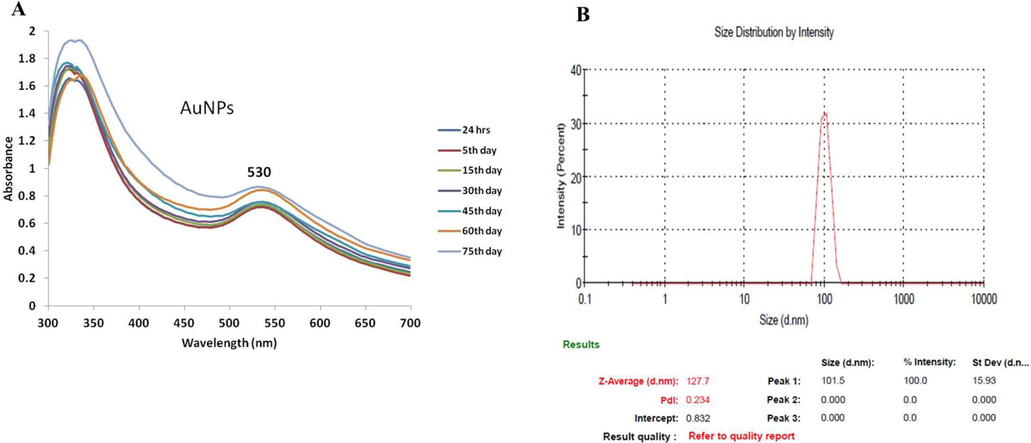
The UV–visible spectrum absorptions at various duration of time (A) and Dynamic Light Scattering (B) of AuNPs formulated from Curcuma wenyujin (CW-AuNPs). The UV spectral analysis of CW-AuNPs revealed the maximum Plasmon resonance peak at wavelength of 530 nm (A), which proves the formation of CW-AuNPs. The size of the gold nanoparticles was investigated using DLS analysis, the Z average diameter was reported to be 127.7 nm (B).
3.1.2 Morphological characterization of CW-AuNPs
Further to confirm the shape and presence of AuNPs in the synthesized CW-AuNP’s TEM analysis was performed. The TEM image of CW-AuNP’s clearly depicts the synthesized CW-AuNPs were spherical in shape and are homogenously distributed (Fig. 2A). The EDAX study confirms the existence of curcumin and gold ions present in the CW-AuNP’s (Fig. 2B).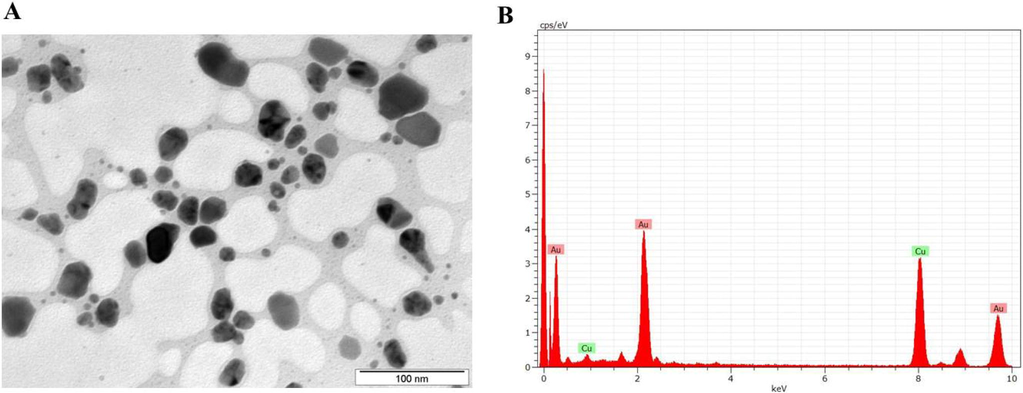
HR-Transmission electron microscopy (TEM) (A) & Energy dispersive X-ray analysis (EDX) of AuNPs formulated from Curcuma wenyujin (CW-AuNPs). The TEM image of CW-AuNP’s clearly depicts the synthesized CW-AuNPs were spherical in shape and are homogenously distributed (A). The EDAX study confirms the existence of curcumin and gold ions present in the CW-AuNP’s (B).
3.1.3 Fourier-transform infrared spectroscopy (FT-IR) analysis of CW-AuNPs:
To assess the biologically active components present in the CW-AuNP’s, FTIR analysis was performed. The maximum spectroscopic peaks were observed at 1000–3500 cm−1. The peaks were observed at 1060, 1719, 1712, 2938, 3534 cm−1. The band at 1060 cm−1 reveals the C—N stretch of amines and the sharp band at 2938, 3534 cm−1 is attributing of —NH stretching of amide (II) band (Fig. 3).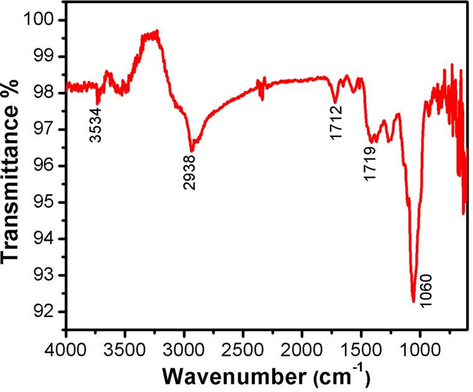
Fourier-transform infrared spectroscopy analysis of AuNPs from the Curcuma wenyujin (CW-AuNPs). The maximum peaks were noted at 1000–3500 cm−1. The band at 1060 cm−1 reveals the C-N stretch of amines and the sharp band at 2938, 3534 cm−1 is attributing of —NH stretching of amide (II) band.
3.1.4 Atomic force microscopy analysis of CW-AuNPs
Fig. 4 depicts the Atomic Force microscopic image of CW-AuNP’s showing the particle size of 100 nm and the 3D image of the CW-AuNP’s which confirms the nanosphere shape of the synthesized AuNPs and also relates with the TEM image.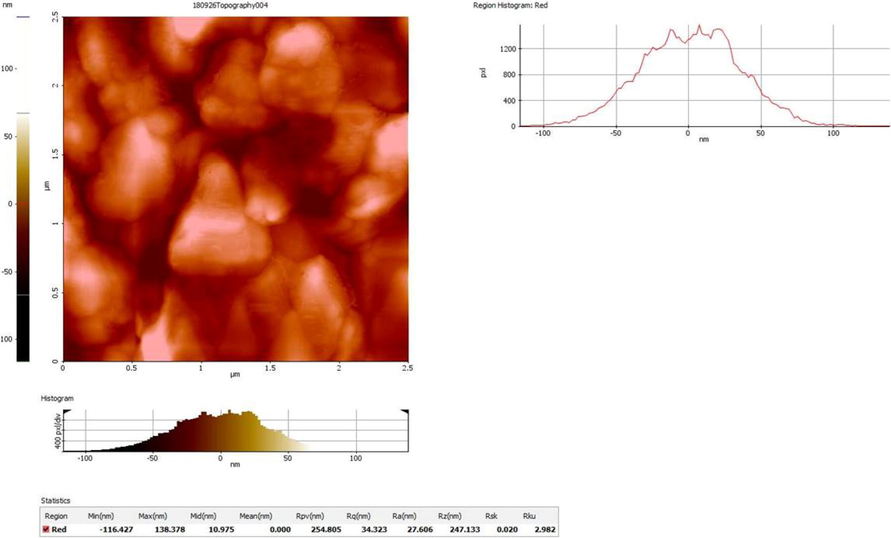
Atomic force microscopic analysis of AuNPs formulated from the Curcuma wenyujin (CW-AuNPs). Figure depicts the Atomic Force microscopic image of CW-AuNP’s showing the particle size of 100 nm and the 3D image of the CW-AuNP’s confirms the nanosphere shape of the synthesized AuNPs.
3.2 Anticancer activity of synthesized CW-AuNPs
3.2.1 CC50 dose analysis of CW-AuNPs
The cytoxicity dose of formulated CW-AuNPs was assessed by MTT assay (Fig. 5). The HER positive breast carcinoma MDA-MB231/HER2 cell line was supplemented with diverse dosages of CW-AuNPs varied from 0 to 30 µg/ml for 24 h and then MTT study was executed. The CC50 value was achieved at the dose of 10 µg/ml, were 50% of cells are dead, hence for further anticancer property analysis of CW-AuNPs three doses CC50 dose 10 µg/ml, a lower dose than CC50 dose 5 µg/ml and a higher dose than CC50 dose 12.5 µg/ml were selected.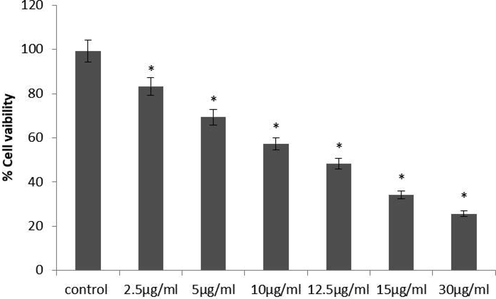
Cytotoxic Effects of AuNPs formulated from the Curcuma wenyujin (CW-AuNPs) against breast carcinoma cell line MDA-MB231/HER2. MDA-MB231/HER2 cells were supplemented with three different dosages of CW-AuNP’s 5 µg/ml, 10 µg/ml, 12.5 µg/ml for 24 h and evaluated for CC50 value with MTT Assay. Each bar represents mean ± SEM of three independent measurements. p < 0.05 is regarded as statistically significant.
3.3 Apoptotic effect of CW-AuNPs against HER positive breast cancer cell line:
3.3.1 Intracellular oxidative status of CW-AuNP treated MDA-MB231/HER2 cell
Fig. 6A signifies the level of intracellular ROS present in normal and CW-AuNPs supplemented MDA-MB231/HER2 cell line. The status of ROS increased in dosage-reliant mode maximum increased level of 275% increase was noticed at the dosage of 12.5 µg/ml and it is 100% increased at the CC50 dose 10 µg/ml. The lower CC50 dose of 5 µg/ml treated cells shown 50% increase in their ROS levels evaluated with the control.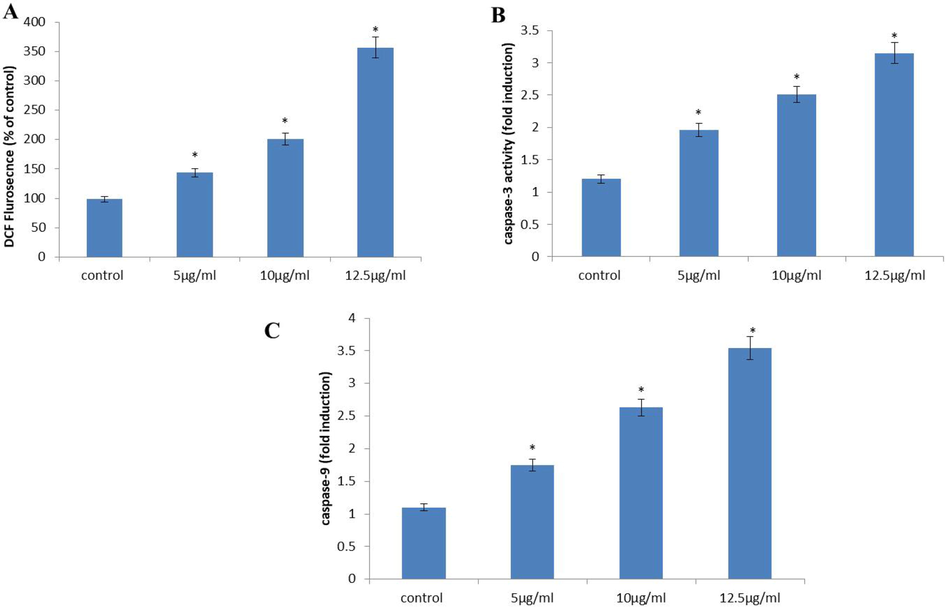
Apoptotic effects of AuNPs formulated from the Curcuma wenyujin (CW-AuNPs) against breast carcinoma cell line MDA-MB231/HER2. MDA-MB231/HER2 cells were supplemented with three different dosages of CW-AuNP’s 5 µg/ml, 10 µg/ml, 12.5 µg/ml for 24 h and assessed for ROS (A), Caspase 3 (B) and Caspase 9 (B). Each bar represents mean ± SEM of three independent measurements. p < 0.05 is regarded as statistically significant.
3.3.2 Effect of CW-AuNP treatment on caspases activities of MDA-MB231/HER2
Caspases are the cysteine-aspartate proteases that perform an essential function in apoptosis. Caspases-3 is an initiator caspases and caspase-9 is the executor caspases. The activities of both caspases were augmented in HER positive breast carcinoma MDA-MB231/HER2 cells supplemented with diverse dosages of CW-AuNPs (Fig. 6B). Caspases activities were increases to two fold in 12.5 µg/ml CW-AuNPs whereas it is 1 and 1.5 fold increased in 5 and 10 µg/ml CW-AuNPs treated cells respectively.
3.4 Anticancer effect of CW-AuNPs against HER positive breast cancer cell line:
3.4.1 Immunocytochemical analysis of HER2/neu protein expression in CW-AuNPs treated MDA-MB231/HER2 cell line
The results of immunocytochemical investigation of HER2/neu protein expression in normal and CW-AuNP’s supplemented cells were represented in the Fig. 7. The green fluorescence which indicates the occurrence of expression of HER2/neu protein were decreased in the CW-AuNPs treated cell. The decrease in the expression of HER2/neu protein were in dose dependent manner and about 0.4, 0.7 and 0.75 fold reduction in the expression of HER2/neu protein were noted in 5, 10, 12.5 µg/ml CW-AuNPs treated cells respectively. The induction of apoptosis by CW-AuNPs were also clearly depicted by the DAPI staining where the intact nucleus were decreased in CW-AuNPs treated cells and the merged image confirms the inhibition of cytoplasmic HER2/neu protein expression by CW-AuNPs in MDA-MB231/HER2 cell line.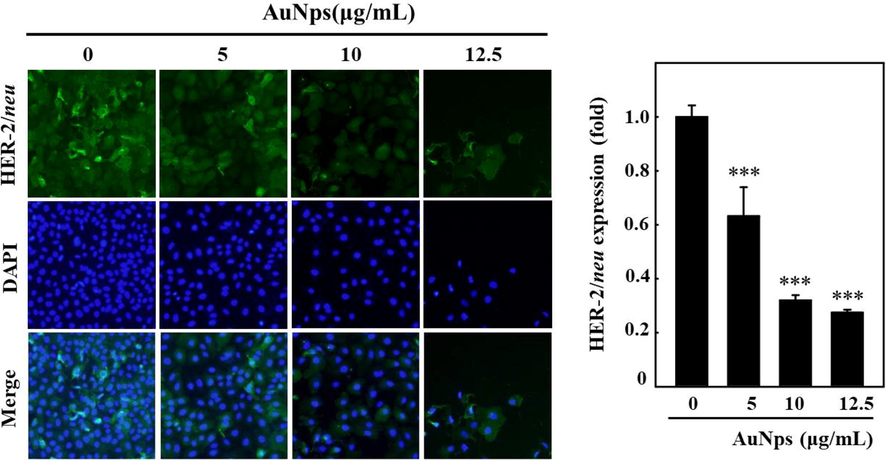
Effect of AuNPs formulated from the Curcuma wenyujin (CW-AuNPs) on HER-2/neu expression in breast carcinoma cell line MDA-MB231/HER2. (A) MDA-MB231/HER2 cells were supplemented with three different dosages of CW-AuNP’s 5 µg/ml, 10 µg/ml, 12.5 µg/ml for 24 h and assessed for HER2/neu protein expression by immunocytochemical analysis. The control and CW-AuNPs treated cells were stained with DAPI staining to measure the apoptosis induction by CW-AuNPs. Each bar represents mean ± SEM of three independent observations. P < 0.05 is considered as statistically significant.
3.4.2 Immunoblotting analysis of HER2/neu protein expression in CW-AuNPs treated MDA-MB231/HER2 cell line
Fig. 8A depicts the HER2/neu and phosphorylated HER2/neu protein expressions in CW-AuNPs treated MDA-MB231/HER2 cell line. Compared to control the CW-AuNPs treated cells showed decreased expression of both total and phosphorylated HER2/neu protein in dose dependent manner. The 0.7 and 0.6 fold of total and phosphorylated HER2/neu protein expression were decreased in 12.5 µg/ml CW-AuNPs treated MDA-MB231/HER2 cell line.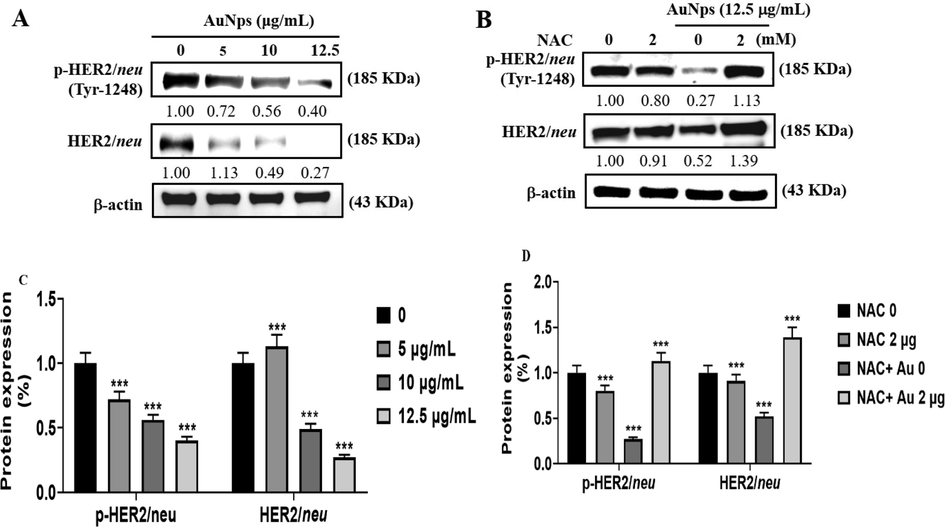
Effect of AuNPs formulated from the Curcuma wenyujin (CW-AuNPs) on immunoblotting analysis of HER-2/neu protein expression in breast carcinoma cell line MDA-MB231/HER2. (A) MDA-MB231/HER2 cells were supplemented with three different dosages of CW-AuNP’s 5 µg/ml, 10 µg/ml, 12.5 µg/ml for 24 h and assessed for HER2/neu protein expression by immunoblotting analysis. (B) MDA-MB231/HER2 cells were pre-administered with N Acetyl cysteine (NAC), antioxidant scavenger and then with three different concentrations of CW-AuNP’s of 5 µg/ml, 10 µg/ml, 12.5 µg/ml for 24 h, then assessed for HER2/neu protein expression by immunoblotting analysis. Each bar represents mean ± SEM of three independent measurements. p < 0.05 is regarded as statistically significant. (C & D) Densitometry analysis of HER-2/neu protein expression in breast carcinoma cell line MDA-MB231/HER2.
To confirm the inhibition of HER2/neu protein expression is via induction of ROS generation, we have pretreated the cells with NAC, a ROS scavenger. The expression of HER2/neu protein were slightly decreased in 2 mM NAC treated cells whereas it is increased when the NAC pretreated cells supplemented with CW-AuNPs at the dose of 12.5 µg/ml (Fig. 8B). It also clearly depicted when treated alone with CW-AuNPs the HER2/neu protein expression were decreased whereas in pretreated cells the HER2/neu protein expression is increased which confirms the inhibition of HER2/neu protein expression is via induction of ROS generation.
4 Discussion
The major global concern of today is cancer, a second leading cause for worldwide mortality. WHO states the frequently affecting majority of women globally is breast cancer (Dubey et al., 2015). Every year nearly 1.67 million new incidences of breast cancer were identified and it comprises about 25% of all cancers (Torre et al., 2015). Even though the occurrence rate of breast cancer is augmented in developed countries, the mortality rate is found to be increased in under developed countries (Shah, 2014). Advancement in the field of cancer treatment increased the survival rate of cancer but the life quality in surviving cancer victims is still a question marker. Most of the chemodrugs used for cancer treatment renders adverse side effects which reduces the life quality of the cancer victims. Phytomedicine is a boon for treating various chronic diseases (Chaudhary et al., 2015). Consequently, in this exploration, we formulated an herbal based nanodrug and inspected the anticancer potential of the drug
Nanoparticles increase the accumulation of drug in tumor cells than the normal cells because of their improved permeability and retention (Acharya and Sahoo, 2011). Utilization of nanoparticles in the medical field increases the potency of the drug by increasing the bioavailability of the drugs. Among all nanoparticles gold nanoparticles possess characteristic physical and chemical properties which symbolize it as a promising agent in the nano-medicines (Chanda et al., 2010). In the current investigation, we fabricated herbal based gold nanoparticles with Curcuma wenyujin, rhizome plant used in the traditional medicine of Chinese. The formation of AuNPs was identified with the red coloration, which is because of the surface resonance capacity of gold and the regular distribution of AuNPs in the solution (Venkatesan et al., 2014).
The shape of the formulated CW-AuNPs were noted via TEM investigation, obviously illustrates the spherical shaped the nanoparticles which is the peculiar electronic and optical features of AuNPs (Chandran et al., 2006). The EDAX investigation revealed the existence of Au particles that proved the generation of AuNPs. The bio-reduction of Au(III) to Au(0) was inspected via FTIR, the characteristic peaks at 1060, 1719, 2938, 3534 cm−1 indicates the reduction of Au that possibly because of the polyphenols that binds the Au metal with carbonyl group and cap the AuNP, consequently averting from nanoparticles aggregation. AuNPs are fabricated via binding of negative charged AuCl4 with positive charged ions (Srivastava et al., 2013). In this exploration the active constituents of Curcuma wenyujin may bind with AuCl4 and reduce it to formation of AuNPs. The dimensional measurement of nanoparticles is unique and depends on the size of the particles. In the present study the AFM analysis of CW-AuNP’s showed spherical shaped nanoparticles at a size of 100 nm, this improves the solubility of the drug and increases its bioavailability.
Numerous researches have reported Curcuma wenyujin possess antioxidant, antidepressant, anti-inflammatory, anticarcinogenic properties (Gukovsky et al., 2003; Xiaoxiao et al., 2009). The synthesized CW-AuNP’s effectively inhibited the breast carcinoma cell line MDA-MB231/HER2 at CC50 dose of 10 μg/mL. This is very less dose compared to previous studies where aqueous extract of Curcuma wenyujin inhibited HepG2 cell line at dose of 70 μg/ml (Xiao et al., 2007); it may be due to the potency of nanoparticle which inhibited the cancer cell line at very less dosage. The balance in redox status of the cells only regulates cell apoptosis, which is deregulated in the cancerous condition. The augment in the status of intracellular ROS generation in tumor cells plays critical role in apoptosis induction. Therefore we measured the ROS levels generated by CW-AuNP’s in breast carcinoma cell line, CW-AuNP’s increased the levels of ROS in MDA-MB231/HER2 cells in a dose-reliant mode that signifies the induction of apoptosis by CW-AuNP’s in MDA-MB231/HER2 cell line. This finding was coincides with the previous report on the apoptotic induction ability of AuNPs from Curcuma wenyujin extract against the human renal cell carcinoma (A498) cells (Liu et al., 2019).
Apoptosis or the programmed cell death is a key mechanism, which inhibits the cancer cell progression (Franco et al., 2009). Caspases are cysteine proteases which induce carcinogenesis, neurodegeneration, immunodeficiency and autoimmunity (Duclos et al., 2017). Caspases are classified into initiator, executor and inflammatory caspases, they implicated both extrinsic and intrinsic apoptotic cascades (Elmore, 2007; Olsson and Zhivotovsky, 2011). In our study CW-AuNP’s effectively increased the activity of caspase 3 and 9 which may be due to the increased level of ROS generation. The DAPI staining of CW-AuNP’s treated MDA-MB231/Her2 cells showed decreased number of intact nuclear DNA which is due to apoptosis induced by the increased level of caspases.
To further analyze the anticancer potential of synthesized CW-AuNP we assessed the HER2/neu protein expression in normal and CW-AuNP supplemented MDA-MB231/HER2 cells. HER2/neu protein is over-expressed in most of the breast cancer victims and it plays a key role in drug resistance, consequently we inspected the potentials of CW-AuNP’s on HER2/neu protein expression. Our CW-AuNP’s particles effectively inhibited the expression of HER2/neu protein in CW-AUNP’s, this was evidently illustrated in our both immunoblotting and immunocytochemical investigations. Further to confirm whether the decrease in HER2/neu protein expression is due to increase in ROS generated by CW-AuNP, the MDA-MB231/HER2 cells were pre-supplemented with N-acetyl cysteine (NAC), a potent antioxidant scavenger. The levels of HER2/neu protein expression is increased in NAC pretreated cells compared to CW-AuNP’s alone treated cells this signifies the inhibition of HER2/neu protein expression is only due to the induction of ROS generated by CW-AuNP’s. Thus our nanodrug CW-AuNP’s effectively decreased the expression of key proto oncogene HER2/neu and inhibited the growth of MDA-MB231/HER2 cells.
5 Conclusion
Our herbal based Curcuma wenyujin gold nanoparticle, is a potent nanodrug which effectively stimulated apoptosis in MDA-MB231/HER2 breast cancer cells. The physiochemical analysis of CW-AuNP’s confirms it is an effective anticancer nano drug which possessed the potent anticancer activity. The results of the UV-Spec, FTIR, TEM and AFM investigations were proved the formation of CW-AuNP’s. The MTT assay results confirmed the cytotoxicity of CW-AuNP’s against the breast carcinoma cell line MDA-MB231/HER2. The immunocytochemical and immunoblotting analysis of HER2/neu protein confirms the inhibitory property of CW-AuNP’s against the key proto oncogene HER2/neu. Our results confirms that the CW-AuNP’s is a persuasive anticancer agent that induces apoptosis via generating ROS and inhibiting proto oncogene HER2/neu expression.
Acknowledgments
This work was funded by Researchers Supporting Project number (RSP-2020/165), King Saud University, Riyadh, Saudi Arabia.
Declaration of Competing Interest
The authors declare that they have no known competing financial interests or personal relationships that could have appeared to influence the work reported in this paper.
References
- PLGA nanoparticles containing various anticancer agents and tumour delivery by EPR effect. Adv. Drug Deliv. Rev.. 2011;63(3):170-183.
- [Google Scholar]
- Physical, emotional and social dimension of quality of life among breast cancer women under chemotherapy. Iranian J. Nursing Res.. 2005;3:55-65.
- [Google Scholar]
- Molecular classification and molecular forecasting of breast cancer: ready for clinical application? J. Clin. Oncol.. 2005;23:7350-7360.
- [Google Scholar]
- Akt promotes cell survival by phosphorylating and inhibiting a Forkhead transcription factor. Cell. 1999;96(6):857-868.
- [Google Scholar]
- Radioactive gold nanoparticles in cancer therapy: therapeutic efficacy studies of GA-198AuNP nanoconstruct in prostate tumor-bearing mice. Nanomedicine. 2010;6(2):201-209.
- [Google Scholar]
- Synthesis of gold nanotriangles and silver nanoparticles using Aloe vera plant extract. Biotechnol. Prog.. 2006;22(2):577-583.
- [Google Scholar]
- Phytomedicine in the treatment of cancer: a health technology assessment. J. Clin. Diagn. Res.. 2015;9(12):XC04-XC09.
- [Google Scholar]
- Breast cancer statistics and prediction methodology: a systematic review and analysis. Asian Pac. J. Cancer Prev.. 2015;16(10):4237-4245.
- [Google Scholar]
- Caspases rule the intracellular trafficking cartel. FEBS J.. 2017;284(10):1394-1420.
- [Google Scholar]
- Apoptosis: a review of programmed cell death. Toxicol. Pathol.. 2007;35(4):495-516.
- [Google Scholar]
- Environmental toxicity, oxidative stress and apoptosis: ménage à trois. Mutat. Res.. 2009;674(1–2):3-22.
- [Google Scholar]
- Curcumin ameliorates ethanol and non-ethanol experimental pancreatitis. Ajp Gastrointestinal Liver Physiol.. 2003;284:85-95.
- [Google Scholar]
- Molecular mechanisms underlying ErbB2/HER2 action in breast cancer. Oncogene. 2000;19:6102-6114.
- [Google Scholar]
- Quality of life and related factor in cancer patients. Behbood. 2006;10(2):110-119.
- [Google Scholar]
- Antimicrobial activity and cytotoxicity of the essential oil of Curcuma zedoaria. Am. J. Chin. Med.. 2004;32(2):281-290.
- [Google Scholar]
- Curcuma wenyujin extract induces apoptosis and inhibits proliferation of human cervical cancer cells in vitro and in vivo. Integrative Cancer Therapies. 2010;9:36-49.
- [Google Scholar]
- Apoptotic effect of green synthesized gold nanoparticles from Curcuma wenyujin extract against human renal cell carcinoma A498 cells. Int J Nanomedicine.. 2019;14:4091-4103.
- [Google Scholar]
- Clinical/ genetic features in hereditary breast cancer. Breast Cancer Res. Treat.. 1990;15:63-71.
- [Google Scholar]
- Anti-inflammatory sesquiterpenes from Curcuma zedoaria. Nat. Prod. Res.. 2006;20(7):680-685.
- [Google Scholar]
- Role of HER2 gene overexpression in breast carcinoma. J. Cell Physiol.. 2000;182:150-162.
- [Google Scholar]
- Rapid colorimetric assay for cellular growth and survival: application to proliferation and cytotoxicity assays. J. Immunol. Methods. 1983;65(1–2):55-63.
- [Google Scholar]
- Green nanotechnology from tea: phytochemicals in tea as building blocks for production of biocompatible gold nanoparticles. J. Mater. Chem.. 2009;19(19):2912-2920.
- [Google Scholar]
- A truncated β-catenin disrupts the interaction between E-cadherin and α-catenin: a cause of loss of intercellular adhesiveness in human cancer cell lines. Cancer Res.. 1994;54(23):6282-6287.
- [Google Scholar]
- Phytosphingosine in combination with ionizing radiation enhances apoptotic cell death in radiation-resistant cancer cells through ROS-dependent and -independent AIF release. Blood. 2005;105:1724-1733.
- [Google Scholar]
- Phase II study of receptor-enhanced chemosensitivity using recombinant humanized anti-p185HER2/neu monoclonal antibody plus cisplatin in patients with HER2/neu-overexpressing metastatic breast cancer refractory to chemotherapy treatment. J. Clin. Oncol.. 1998;16(8):2659-2671.
- [Google Scholar]
- Does arehabilitation program improve quality of life in breast cancer patients. Payesh. 2010;9(1):61-68.
- [Google Scholar]
- Evaluating the risk factors of breast cancer using the analysis of tree models. Ofogh-e-Danesh. J. Gonabad Univ. Med. Sci.. 2011;17(2):60-69.
- [Google Scholar]
- Shah, S., 2014. BreastCancerIndia.net. Retrieved January 30, 2014, from http://www.breastcancerindia.net/.
- Biogenic synthesis and characterization of gold nanoparticles by Escherichia coli K12 and its heterogeneous catalysis in degradation of 4-nitrophenol. Nanoscale Res. Lett.. 2013;8(1):70.
- [Google Scholar]
- The experimental study of proliferation inhibition and apoptosis induction of serum with different curcuma in ovarian cancer cell HO-8910. Lishizhen Med. Mater. Med. Res.. 2013;24:2313-2315.
- [Google Scholar]
- Comparison of anti-inflammatory activities of six curcuma rhizomes: a possible curcuminoid-independent pathway mediated by Curcuma phaeocaulis extract. Evid. Based Complement Alternat. Med.. 2006;3:255-260.
- [Google Scholar]
- Marine algae-mediated synthesis of gold nanoparticles using a novel Ecklonia cava. Bioprocess Biosyst. Eng.. 2014;37(8):1591-1597.
- [Google Scholar]
- Data mining analysis of Professor Liu Shangyi’s prescription characteristics in clinical medicine for the treatment of cancer patients with stomachache. Traditional Med. Res.. 2018;3(1):52-61.
- [Google Scholar]
- Furanodiene induces G(2)/M cell cycle arrest and apoptosis through MAPK signaling and mitochondria-caspase pathway in human hepatocellular carcinoma cells. Cancer Biol. Ther.. 2007;6:1044-1050.
- [Google Scholar]
- Survey of investigations on Daodi Chinese medicinal materials in China since 1980’s. Chin. J. Chin. Mater. Med.. 2009;34:519-523.
- [Google Scholar]
- Furanodiene, a natural product, inhibits breast cancer growth both in vitro and in vivo. Cell Physiol. Biochem.. 2010;30(2):778-790.
- [Google Scholar]
- Zhou, Binhua P., Hu, Mickey C.-T., Miller, Stephanie A., Yu, Zhenming, Xia, Weiya, Lin, Shiaw-Yih, Hung, Mien-Chie, 2000. HER-2/neu blocks tumor necrosis factor-induced apoptosis via the Akt/NF-kB pathway, 275, 8027–8031.
- Formononetin inhibits migration and invasion of MDA-MB-231 and 4T1 breast cancer cells by suppressing MMP-2 and MMP-9 through PI3K/AKT signaling pathways. Horm. Metab. Res.. 2014;46:753-760.
- [Google Scholar]







